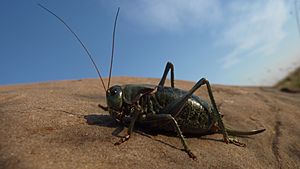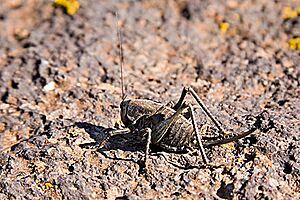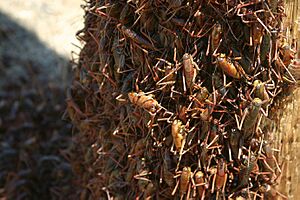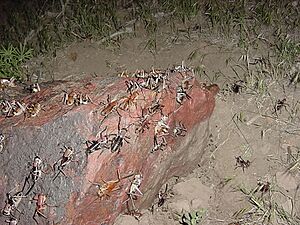Mormon cricket facts for kids
Quick facts for kids Mormon cricket |
|
|---|---|
 |
|
| Scientific classification | |
| Genus: |
Anabrus
|
| Species: |
simplex
|
The Mormon cricket (Anabrus simplex) is a large insect that can grow to almost 8 centimeters (3 inches) long. It lives across western North America in areas with sagebrush and other plants called forbs. Even though it's called a cricket, it's actually a type of katydid. It got its name from early Mormon settlers in Utah. They saw these insects when they moved west. The Mormon cricket is also famous for its role in the miracle of the gulls.
Mormon crickets cannot fly. But they can travel up to two kilometers (about 1.2 miles) a day when they are in their swarming phase. During this time, they can cause big problems for farms and even make roads dangerous.
Contents
What Does a Mormon Cricket Look Like?
Mormon crickets come in many different colors. They can be black, brown, red, purple, or green. The "shield" behind their head, which is called the pronotum, might have colorful marks. Their body might also look striped. Female crickets have a long part called an ovipositor. This is used for laying eggs and should not be confused with a stinger. Both male and female crickets have long antennae.
When there are many Mormon crickets in one place, their bodies can change. This is similar to how locusts change. The biggest change is in their color. Crickets living alone are usually green or purple. But crickets that are swarming together are often black, brown, or red.
Mormon Cricket Life Cycle
Most Mormon cricket eggs hatch in the spring after they are laid. However, in some places, eggs can take up to five years to hatch! Hatching starts when the soil gets warm enough, around 4.4 degrees Celsius (40 degrees Fahrenheit). Young crickets, called nymphs, grow through seven stages. After about 60 to 90 days, they become adult crickets.
Adult crickets start to breed about 10 to 14 days after they become adults. The male gives the female a large package of food and sperm called a spermatophore. This package can be up to 27% of the male's body weight! The female eats most of this package, which helps her get enough food to lay eggs. Because of this special "gift," female crickets in swarms might even compete to find males. This behavior is not seen in crickets that live alone.
The female lays her eggs by pushing her ovipositor deep into the soil. Each female can lay over one hundred eggs. The eggs look like grains of rice and are gray to purplish in color.
Why Mormon Crickets Swarm
Most of the time, Mormon crickets live in small groups. But sometimes, their numbers explode! This creates huge groups of crickets that move together in bands. These bands can have millions of crickets. There can be up to 100 crickets in just one square meter (about 10 square feet). These big outbreaks can last for years or even decades. Scientists think that weather might play a role in why these outbreaks happen.
Research shows that Mormon crickets move in these large groups for two main reasons. First, they are looking for new places to find important food like protein and salt. Second, they move to avoid being eaten by other hungry crickets behind them! Mormon crickets can be cannibalistic, meaning they eat other crickets. This might make them keep moving forward to stay safe from their own kind.
When a large group of crickets crosses a road, it can be dangerous. Drivers might get distracted, and the road can become very slippery from crushed crickets. These swarms can also cause a lot of damage to crops and gardens.
What Mormon Crickets Eat
Mormon crickets really like to eat forbs. But they also eat grasses and shrubs like sagebrush. They also eat other insects, including other Mormon crickets. They especially eat crickets that have been hurt or killed by cars or bug sprays. Eating other crickets might happen when they don't have enough protein and salt. Moving in swarms might be a way for them to avoid being eaten by other Mormon crickets.
During a big outbreak, Mormon crickets can cause a lot of harm to farms and home gardens.
How to Control Mormon Crickets
Many different birds and mammals eat Mormon crickets. These include California gulls, crows, coyotes, and various small animals like rodents. No animal eats only Mormon crickets. This might be because the crickets move around a lot and their numbers change a lot. A type of horsehair worm called Gordius robustus is a parasite of the Mormon cricket. Another parasite is Ooencyrtus anabrivorus.
One common way to control them is using a chemical called carbaryl. This is often sold as "Sevin Dust" bait. This bait kills crickets that eat it. It also kills other crickets that eat the crickets that ate the bait. Spraying bug killer directly on crops might kill some crickets. But because the swarms are so big, this usually doesn't save the crops from being destroyed.
Since Mormon crickets cannot fly, physical fences can work. These barriers should be at least two feet (about 60 cm) high and made of a smooth material. People in some towns have even used loud music from boom boxes and sound systems. They play hard rock music to try and make the swarms move away from their homes and farms.
Another way to control Mormon crickets is using a natural bug killer made from a fungus called Nosema locustae. This fungus is found in nature. Its tiny spores kill crickets by hurting their digestive system. The U.S. Environmental Protection Agency says that using this fungus does not harm people or the environment.
Mormon Crickets in History
Mormon crickets were part of the traditional diets of some Native American groups.
In 2003, officials in Utah, Idaho, and Nevada said that the cricket outbreak that year might have been the worst in recent history.
See also
 In Spanish: Grillo mormón para niños
In Spanish: Grillo mormón para niños





